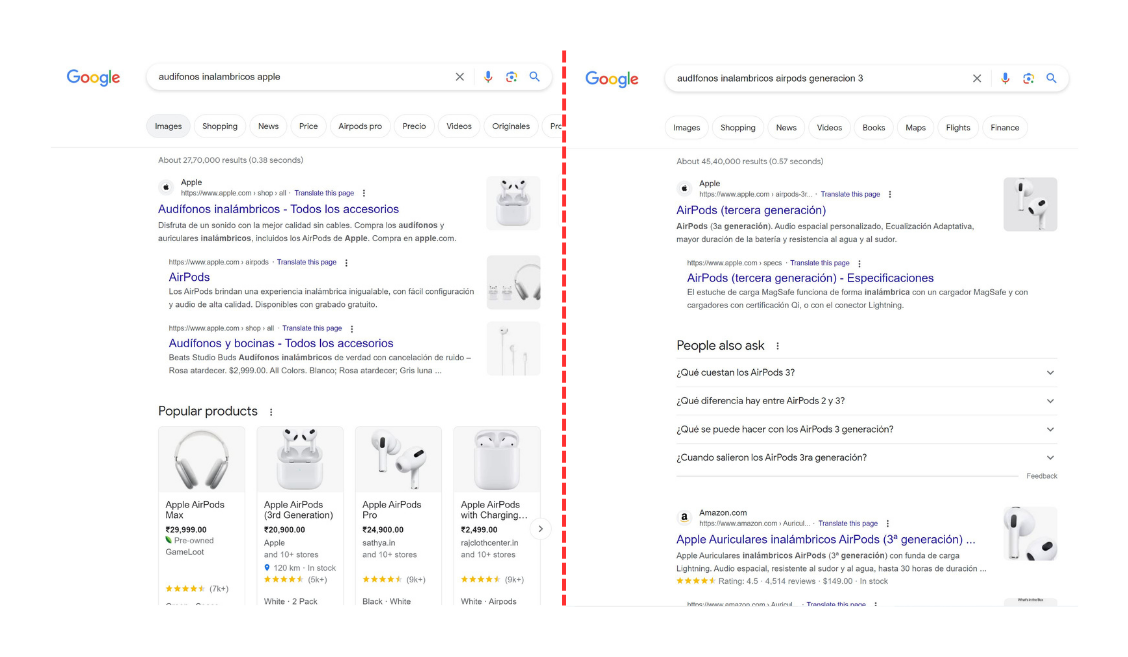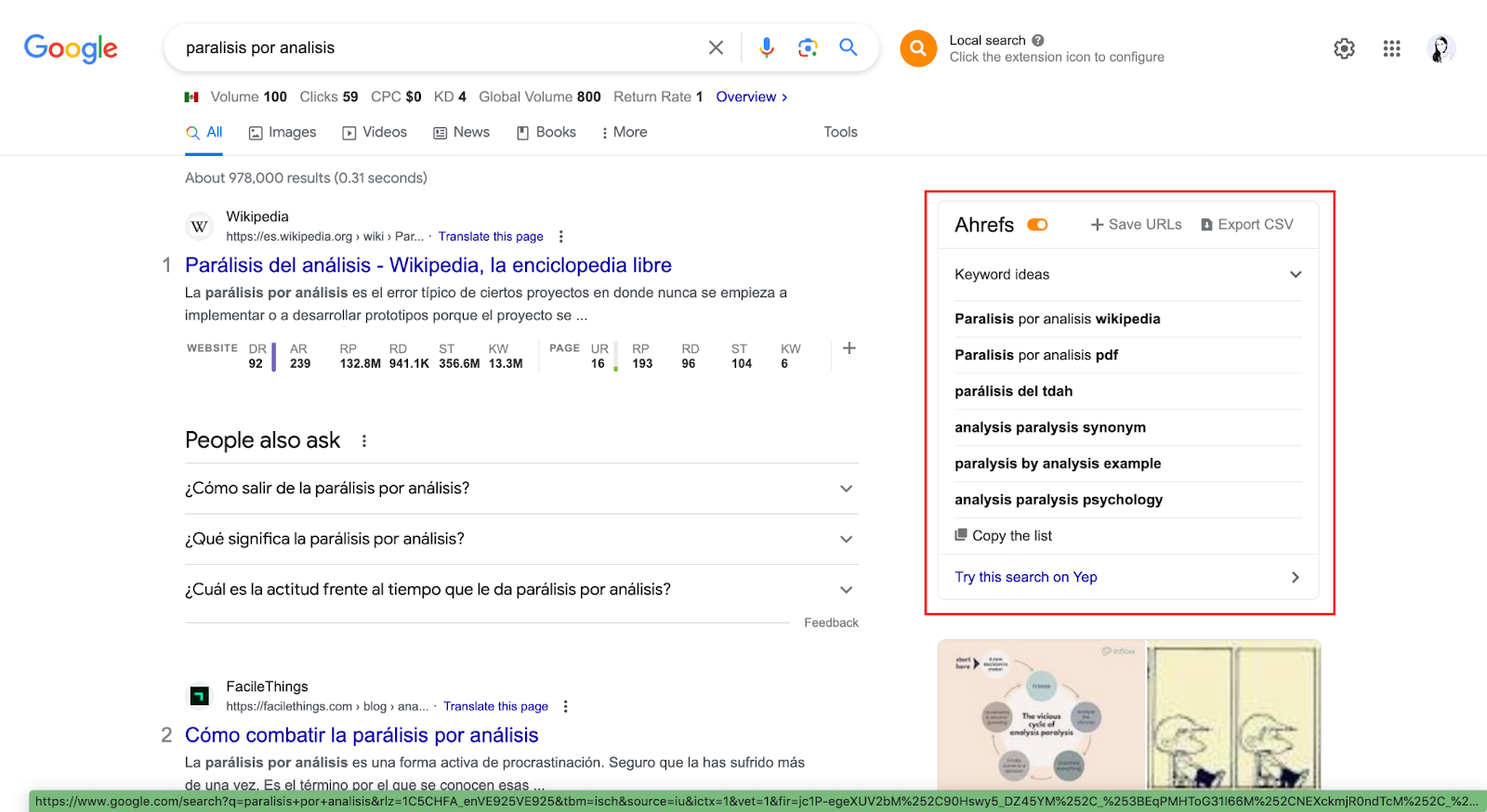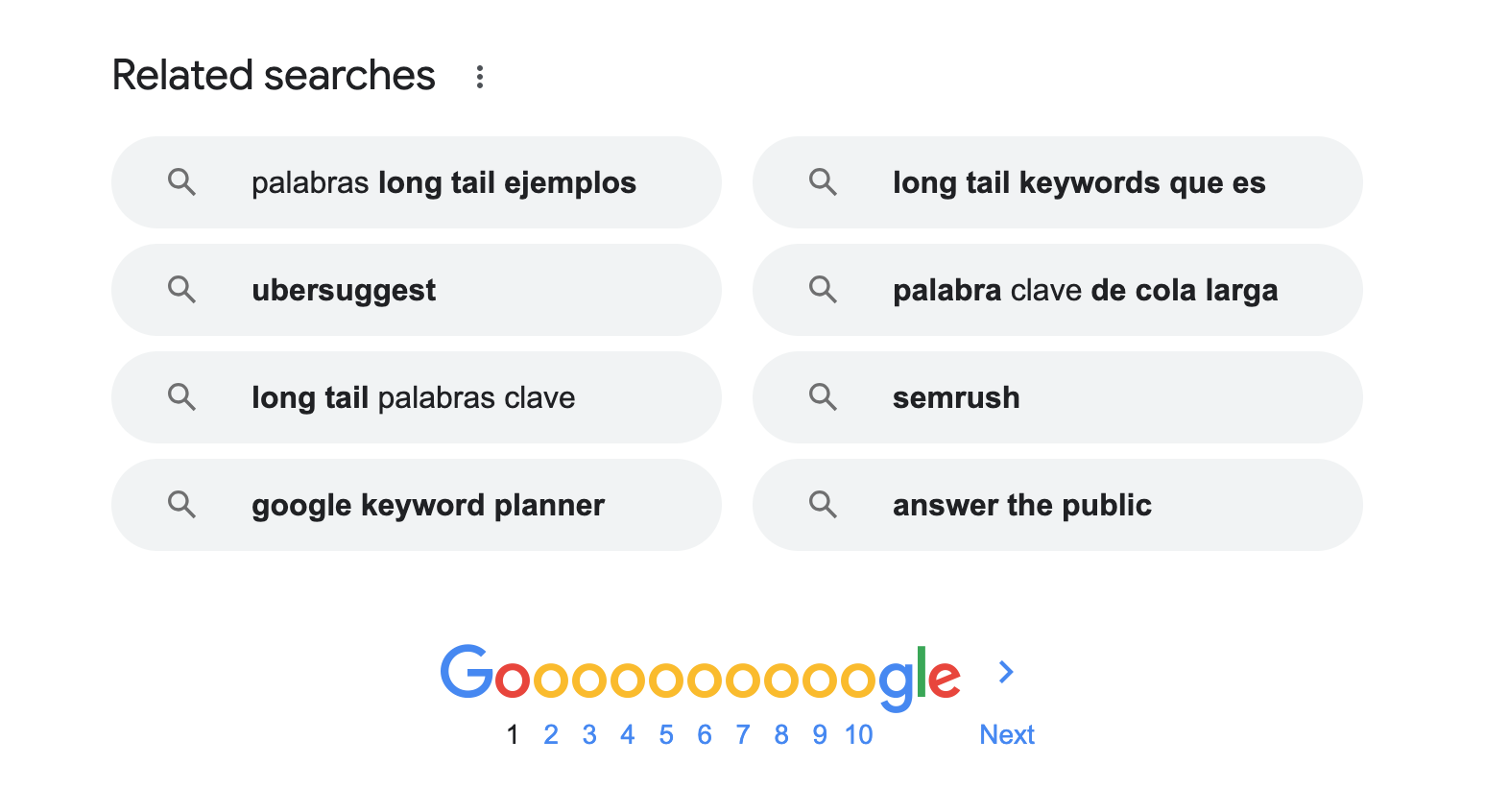Types of Keywords and How to Find Them: Complete Guide 2024
Keywords continue to be part of various SEO strategies to position websites and improve their visibility in search engines. In this complete guide you will find all the types of keywords that exist, examples of each one of them and tools and strategies to find each type.
Keywords vs. Searches
⚠ Before understanding the types of keywords, it is first important to differentiate:
- Keyword: The main topic or idea of a search. This idea can be extrapolated to various searches. Example: “tight pants”.
- Search: the exact words that the user types into the search engine. Example: “skinny pants size 0”.
In SEO we target keywords and then find the search that we will use as a reference to create our content. That is, for example, the same article that targets a specific keyword can get traffic by ranking in different searches.
Types of keywords
Keywords types can be classified according to:
- Search popularity
- Search intent
- Sales funnel stage
Once you read this subsection, you will see that we can basically classify keywords into short-tail keywords and long-tail keywords . However, as we add variables such as search intent, the stage of the sales funnel + the content that needs to be generated for each sales stage, it will be easier for you to determine which type of keyword you should target.
1. Search popularity
It depends on the search volume of the keyword. It doesn't matter if the keyword is long or not, but rather the demand for it.
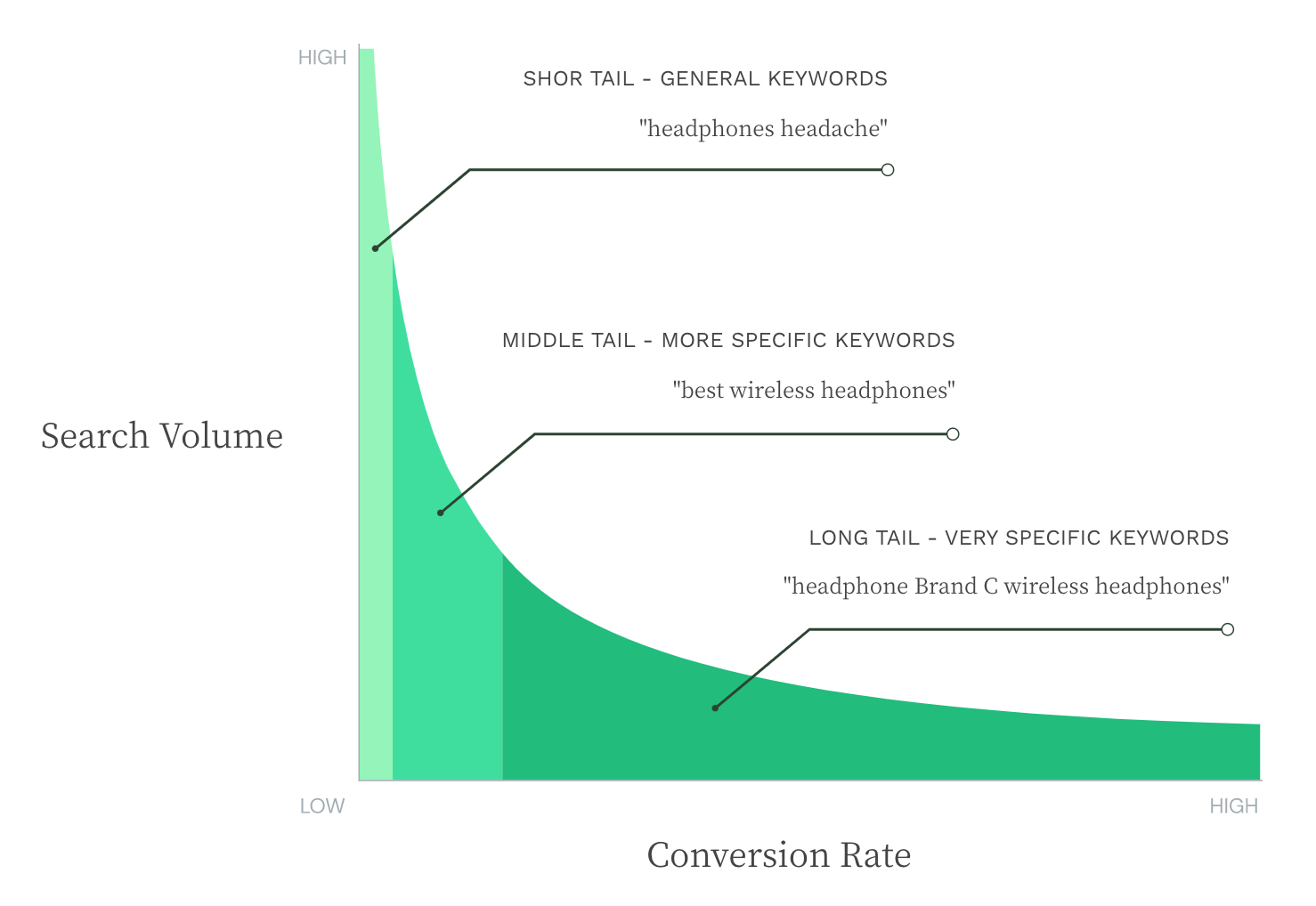
Short-tail keywords
- (↑ volume ↑ potential traffic ↑ KD ( keyword difficulty ) ↓ chance of conversion)
- Many people tend to google short-tail keywords.
- Increased competition to rank.
- Once you manage to rank for these keywords it will bring a lot more traffic to other long-tail keywords.
- To rank for these keywords, it is helpful to apply strategies of: link building, internal linking, refining your site content (coherence and authority in an area).
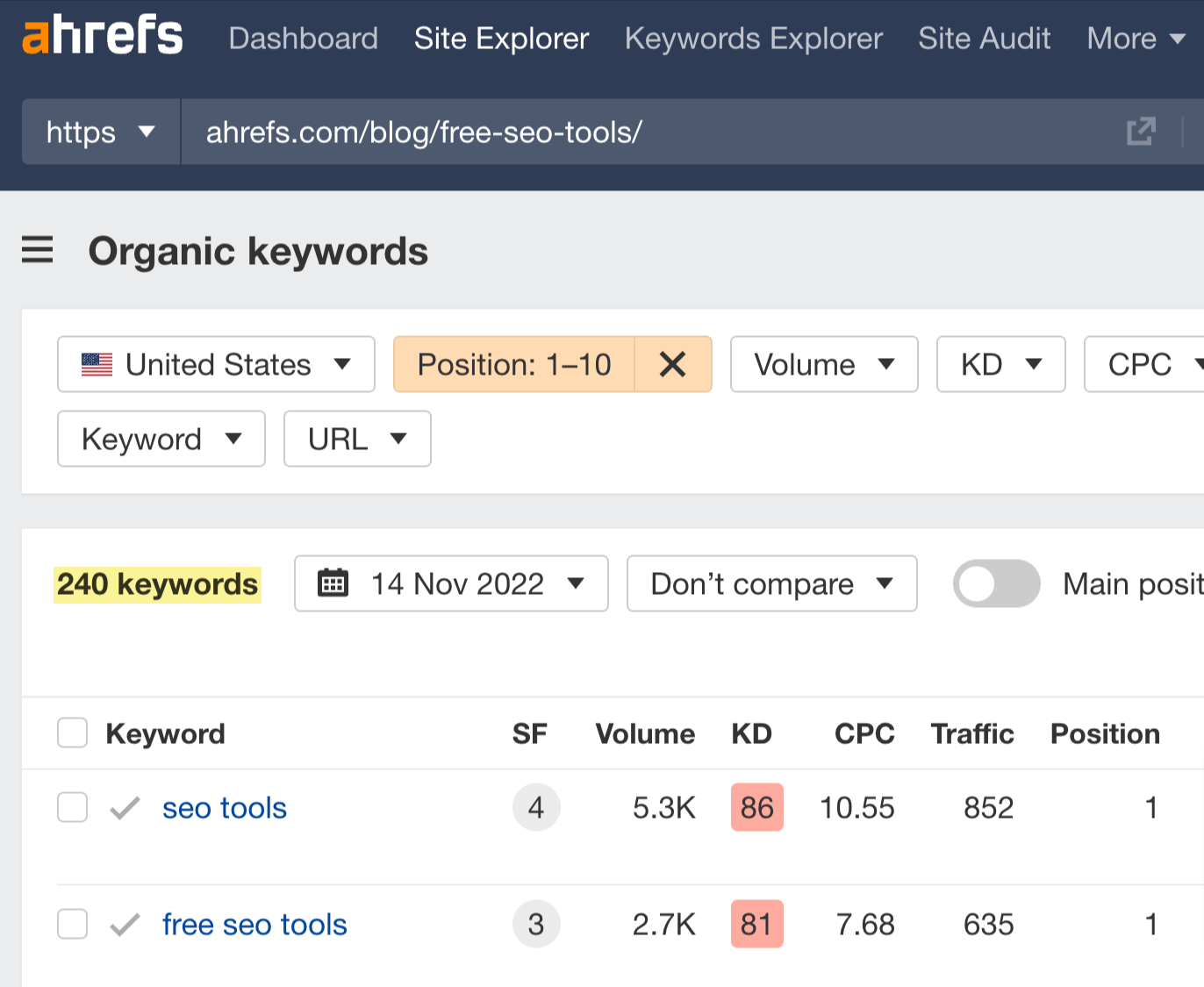
Mid-tail keywords
To be more practical, we will classify middle or mid-tail keywords as long-tail since the main variable for classification is the volume of the keyword and not the length of the keywords in number of words.
However, the more specific the keyword is, you can be sure that it will be a long-tail, otherwise, if it is a medium between a short-tail and a long-tail, it could be a mid-tail, taking into account that it will have the variables of a long-tail.
Long-tail keywords
- (↓ volume ↓ potential traffic ↓ KD ↑ chance to convert)
- Fewer people google this type of keyword.
- It is easier to rank for this type of keyword.
- These are more specific searches.
- There is more variety of keywords.
- You will need to rank for more long-tail keywords to get a lot of traffic.
- There are 2 types of long-tail keywords:
- Supporting long-tail keywords
- Topical long-tail keywords : it is preferable to go for topical long-tail keywords. These are the “ parent keywords” of sub-topics, and are the most famous ones that top-ranking pages rank for.
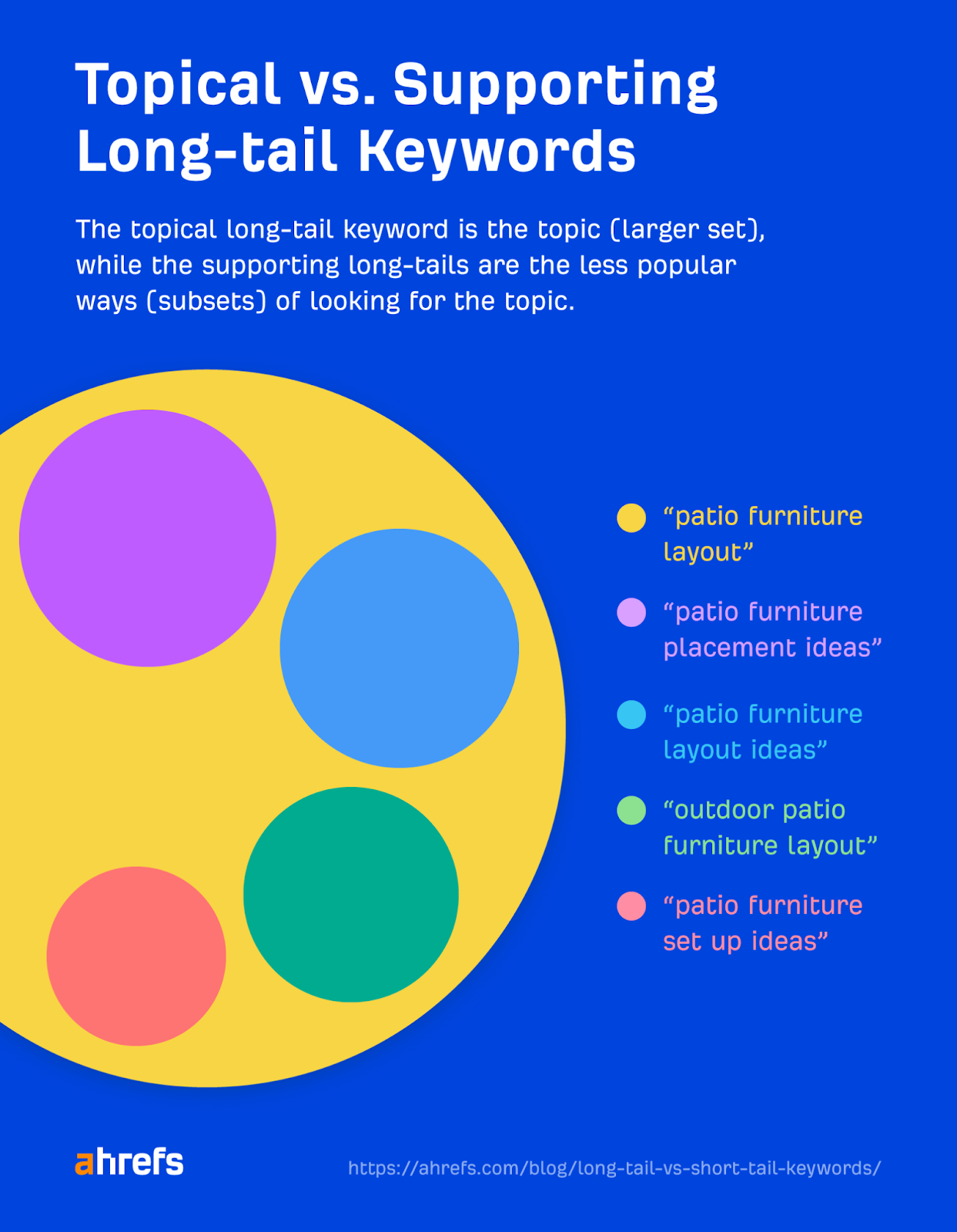
Summary table:
2. Search intent
Depending on the intention that the user has in mind when googling . For example, they may want to understand a topic, learn a concept, know what steps to follow for a process, compare two products, or buy a specific product.
Depending on the types of search intent, the user can perform different types of search, targeting either short or long-tail keywords:
- Informational
- Navigational
- Commercial / Comparison
- Transactional
- Mixed
Table: Keyword modifiers according to each type of search intent
⚠️ Note: Search intent is not directly related to keywords but to the SERP (search results pages). That is, search intent is defined according to the results shown. It is common to find keywords classified according to search intent, however this is not technically correct, but practical. Since search intent can change over time as the SERP changes.
1. Informational:
When the user googles with the intention of finding out more information about something or learning about it for the first time.
In SEO we can find that many websites aim for this strategy using their blog, focusing at the beginning mostly on popular content to start bringing organic traffic to their website and then redirecting that traffic to less popular landing pages (LP) but with a greater chance of conversion.
Keyword Type: Short-tail & Mid-tail keywords.
- Short-tail example: “ headphones bothering ”. Although the type of content is not so specific, some articles talk about the reason for the discomfort and others about tips or advice, it is clear that the user's intention is to read information.
- Mid-tail example: “ why do I feel heavy headed ”. The search intent is more specific.
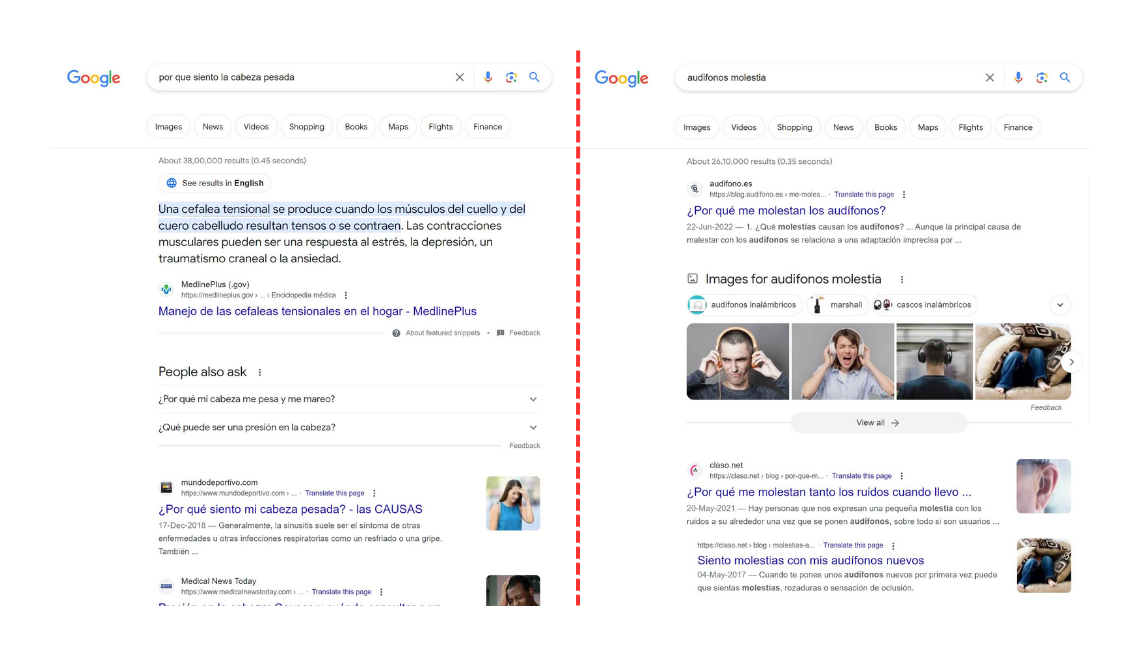
3. Commercial / Comparison
The user is looking for more information about a product/service they want to buy. Articles or landing pages such as: product reviews, product comparison, list of best products.
It is common to find local searches such as: “best restaurants in Mexico City.”
Keyword Type: Mid-tail & Long-tail
- Mid-tail example: “ best wireless headphones ” (higher volume and potential traffic than the next search👇).
- Long-tail example: “ best headphones under $100 ”.
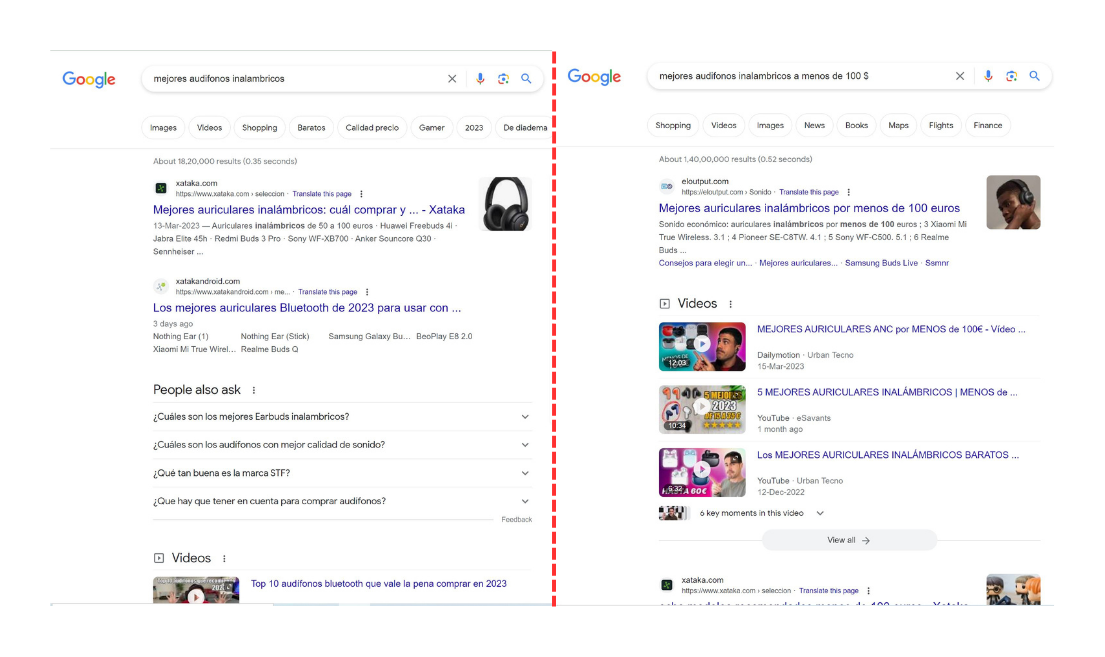
4. Transactional
The user is ready to complete a transaction, whether it is purchasing a product or service, subscribing to a particular service, or engaging in some other type of action. This is the best opportunity to generate conversions.
Keyword Type: Long-tail
- Example: “ buy airpods 2nd generation ”
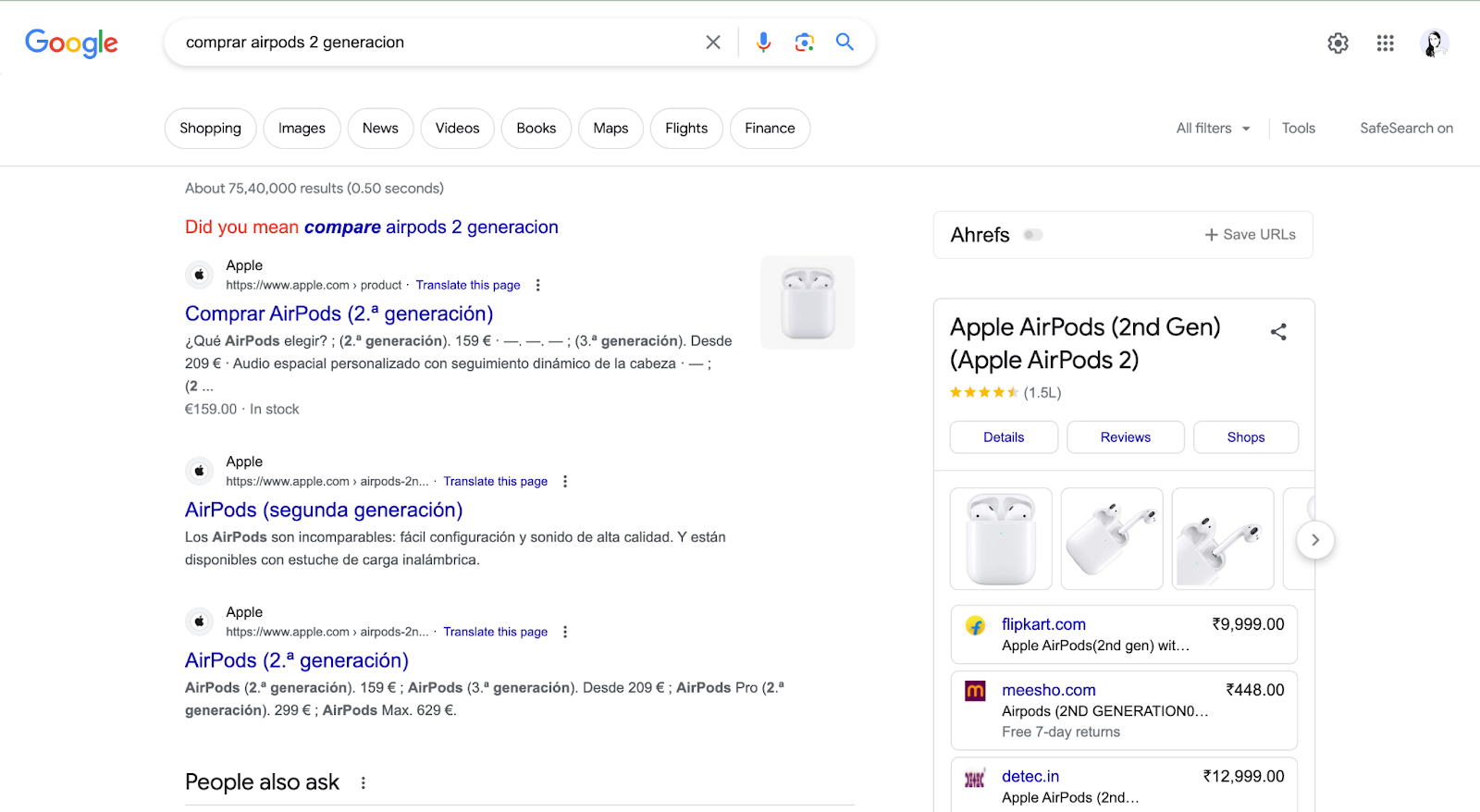
Money keywords
Within the transactional intent, we can find the keywords known as “ money keywords ”. These are directly related to the products or services offered and have a high potential to generate income. They are crucial to boost conversions and sales.
5. Mixed (or split search intent )
Searches that contain both informative articles and product or purchase pages.
It is not advisable to aim to rank for a mixed or split search intent in the first place. If you consider it an opportunity, it is a good strategy to mix product pages with content sections such as frequently asked questions (FAQ). This can help increase the chances of ranking for that search or keyword.
Keyword Type: Short-tail & Mid-tail
The more short-tail or general the keyword is, the more common it is to find mixed search intent.
- Mid-tail example: “ ciso as a service ”. In this search we find product pages offering the CISO service, as well as articles explaining what CISO as a service is. A good strategy would be to create an optimized article targeting “what is CISO” + a landing page with content texts about what CISO is, for example, in a FAQ section.
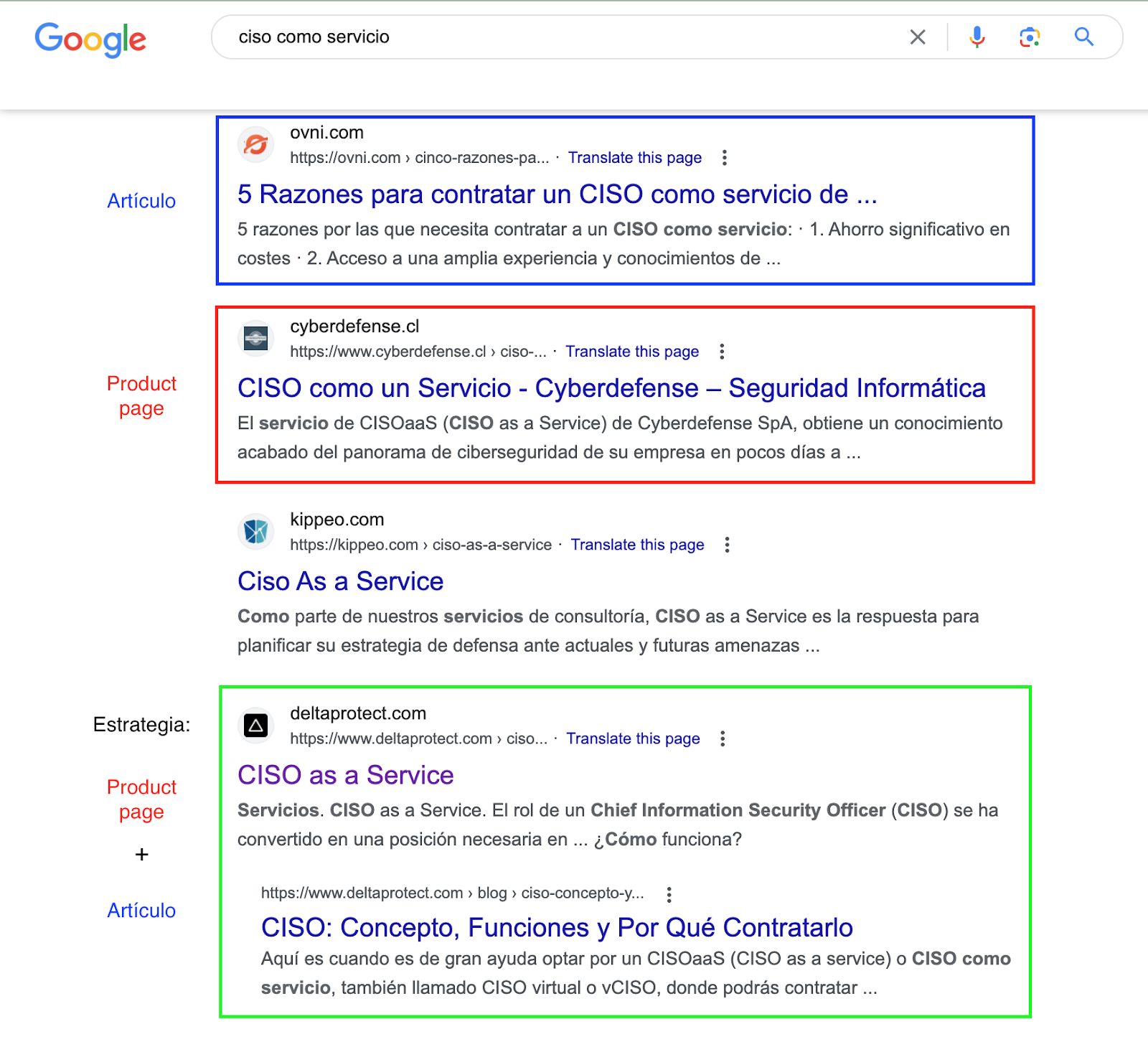
Summary table:
*Although mixed search intent may contain short-tail keywords, the volume and potential traffic may be low since it is not common for the user to interact with fractured search intent searches, since they probably do not find specifically what they want.
3. Sales funnel stage
Now that you know the different types of search intent, each one can be related to a stage of the sales funnel, and with this, it is easier to classify keywords according to the sales stage in which the user is, as well as the content to be generated for said phase.
Although it is the last type of keyword, it is the one that helps the most to define which type of keyword to choose. Basically, the keyword you want to target will depend on what you want the user to do after visiting the page optimized for that keyword.
⚠️ The order of the classification consists of: Sales funnel stage - Awareness level - Content type. The awareness level helps you understand what stage of understanding the problem and solution the potential client is in regarding your brand.
- Awareness: Problem aware - Lead generation content
- Consideration: Solution aware - Nurturing content
- Purchase: Product/Brand aware - Sales content

1. Awareness: Problem aware – Lead generation content
Users become aware of the problem they face (which your brand can solve) and decide to look for more information about it.
Contact with the brand: This is the first time they encounter your brand. They don't know much about your product or service yet.
Content and Call to Action (CTA): This stage focuses on content and lead capture, as well as making it known that you offer a solution to their problem .
- Search intent: Informational
- Keyword Type: Short-tail & Mid-tail
2. Consideration: Solution aware – Nurturing content
The user already knows what their problem is and is considering different ways to solve it, looking for more information about a product or service.
Contact with the brand: If the user has already encountered your brand in informational searches for the same problem, they are likely to consider solving their problem with your services or products. Or, the user had become a lead in the previous stage.
Content and CTA: At this stage you should highlight the values and benefits of your solution compared to your competitors and make the solution, purchase, demo or subscription available in a simple way.
- Search intent: Commercial / Comparison
- Keyword Type: Mid-tail & Long-tail
3. Purchase: Product/Brand aware – Sales Content
The user chooses a solution and becomes a customer.
Brand Contact: The user found you by searching for your brand name directly or found you in search results where they Googled the exact product or service they want to purchase.
Content and CTA: At this stage, you should have product pages that are optimized for content, clear and easy to interact with to make the purchase without too many obstacles.
- Search intent: Transactional & Navigational
- Keyword Type: Short-tail (search by brand) & Long-tail (search for specific product/service)
Summary table:
How to find keywords: 6 ways to search for keywords
First, you need to be clear about what type of keyword you want to target so that you know which method or tool to use. With all of the content above, you can learn to identify which keyword you want or need to target.
- Ahrefs
- Semrush
- Answer the Public
- AlsoAsked
- Quora, Reddit and other niche forums
1. Ahrefs
With Ahrefs you can find keywords by analyzing: competitors (from all pages on their website or a specific landing page), searches, reference articles or product pages, example keywords, and your own website.
Competitors and own website | “ Site explorer - Top pages”
With this method you can see the landing pages that bring the most organic traffic to a website, along with the top keyword that ranks for them. You can analyze your competitors' keywords, as well as the ones your site is ranking for.
- If you only want to find ideas for article topics, instead of leaving the domain URL, you could leave the blog URL, if it is in a single folder such as “/blog”.
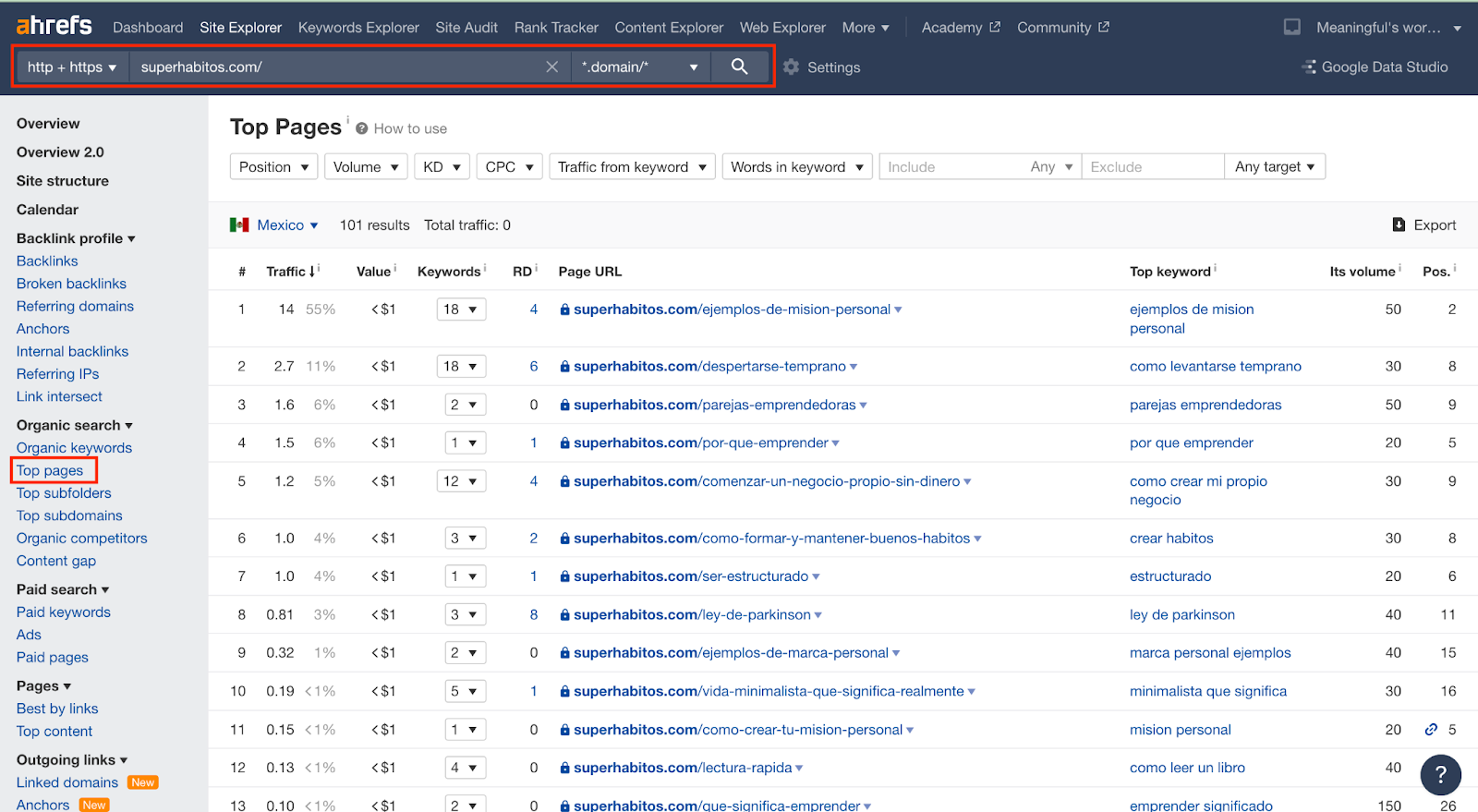
Competitors and own website | “ Site explorer - Organic keywords”
Here you can directly see the keywords of a website that bring the most organic traffic.
Unlike the previous method, you can see the keyword difficulty (KD) of each one and you will also find several keywords that drive traffic to the same landing page.
- Since it is sorted by highest traffic, you will naturally find short or mid-tail keywords first. This does not mean that you cannot find long-tail keywords.

Competitors | “Site explorer - Organic competitors - Competitor's keywords”
This method works both to find competitors of one of your competitors or your own competitors at the keyword level.
- By clicking on “Competitor's keywords” you can see the words that your competitor is ranking for and you are not.
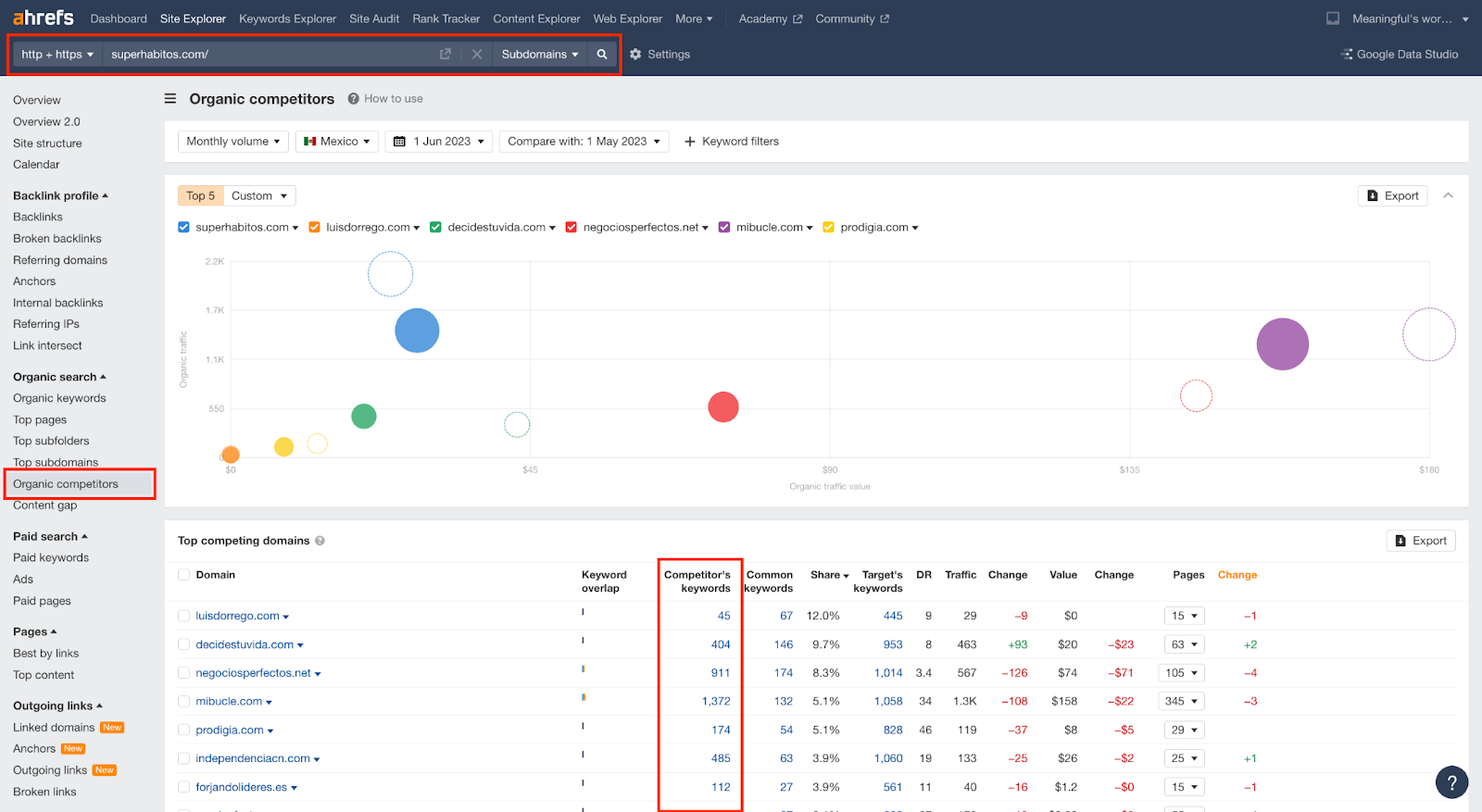
“Keywords explorer”
This is similar to Semrush’s keyword exploration option (“keyword overview”), described below. Here you can analyze the ranking opportunity of a keyword you have in mind or have found on a landing page.
- Please be sure to specify the country of interest.
- Here we are mainly interested in checking the KD, potential traffic and volume by country.
- You might also get keyword ideas, which could be mid- and long-tail variations of an analyzed short-tail.
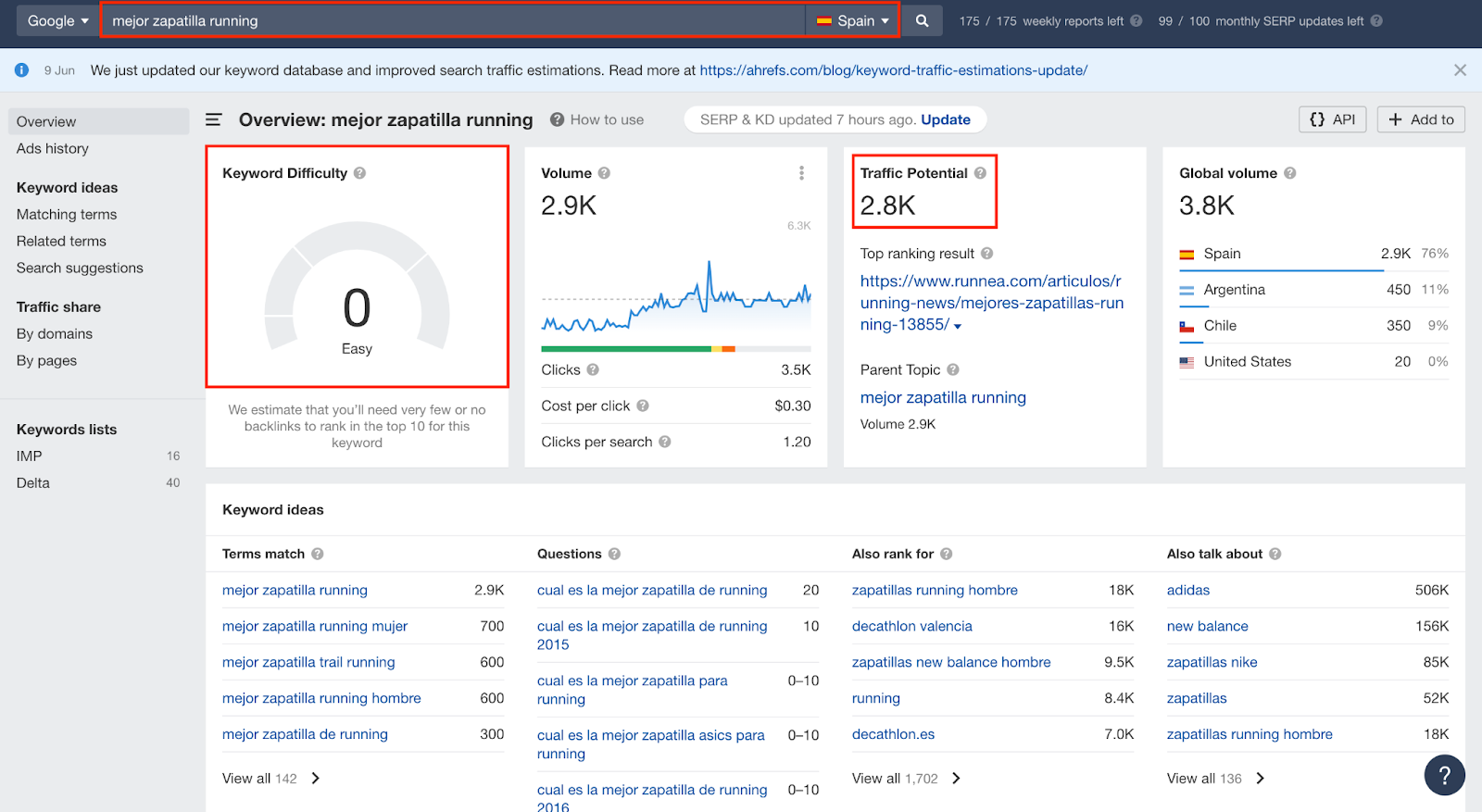
⚠️ Pro-tip: We recommend that you mostly use the keyword analysis from the Keywords report that you can get from a search with the Ahrefs Chrome extension , since the keywords explorer feature has a limited number of analyses available, while when viewing the full keywords report for a site, you don't have a limit on the number of reports.
Search or Landing page | Keywords of a landing page (“ KW ”)
- You can access from the SERP:
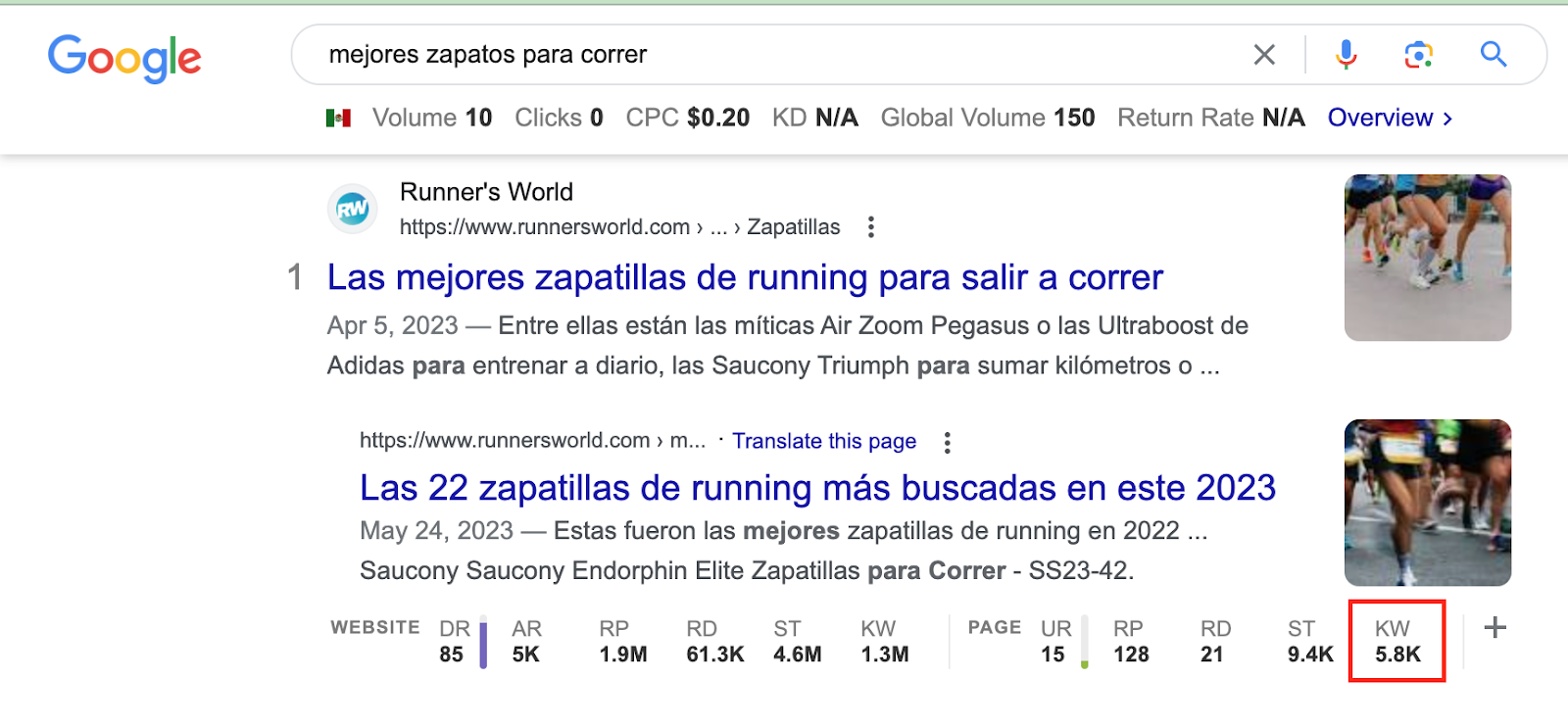
- Or, from the landing page using the Ahrefs Chrome extension :
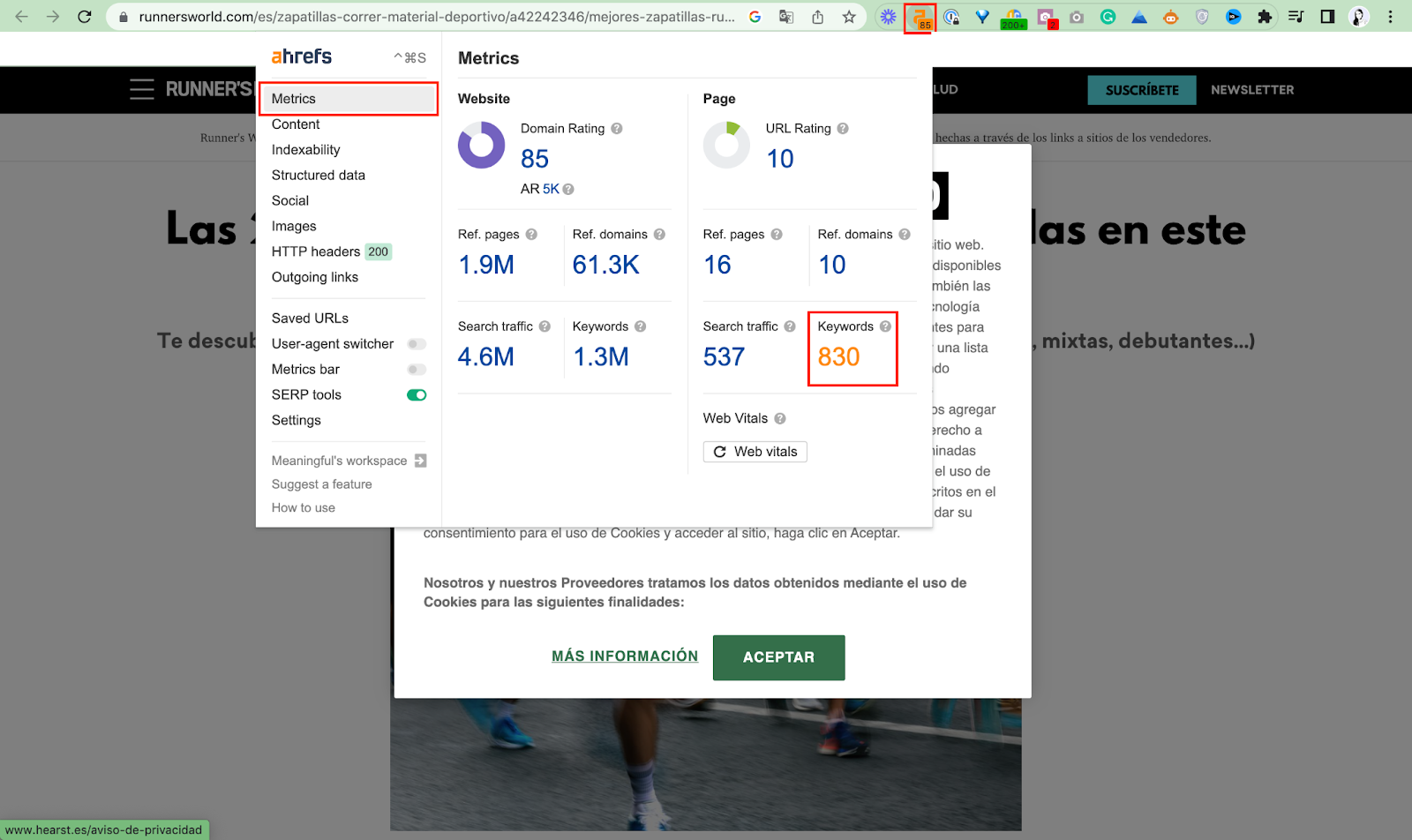
2. Semrush
Semrush has similar tools to Ahrefs, however, some of them are more comprehensive for keyword research. Here we describe them:
“Keyword gap”
- Compare your competitors' keywords with your own and find keyword ranking or optimization opportunities.
- Unlike Ahrefs' tool, in this case you need to know which competitors you want to compare.
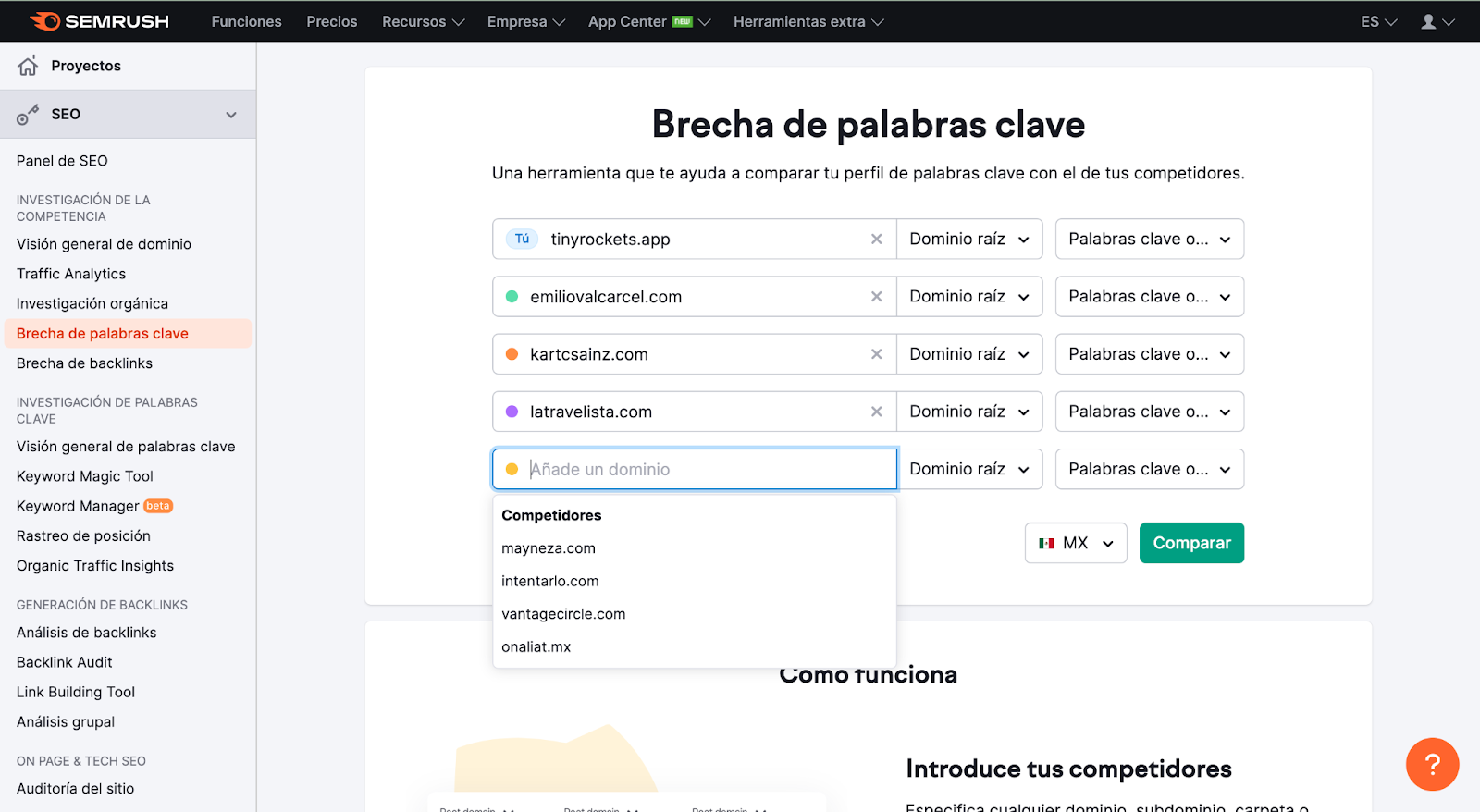
- It differs from Ahrefs’ “Organic competitors” feature in that:
- Instead of having only the unique keywords for each player and the ones common to your website, Semrush also offers the keywords that you have weak or strong.
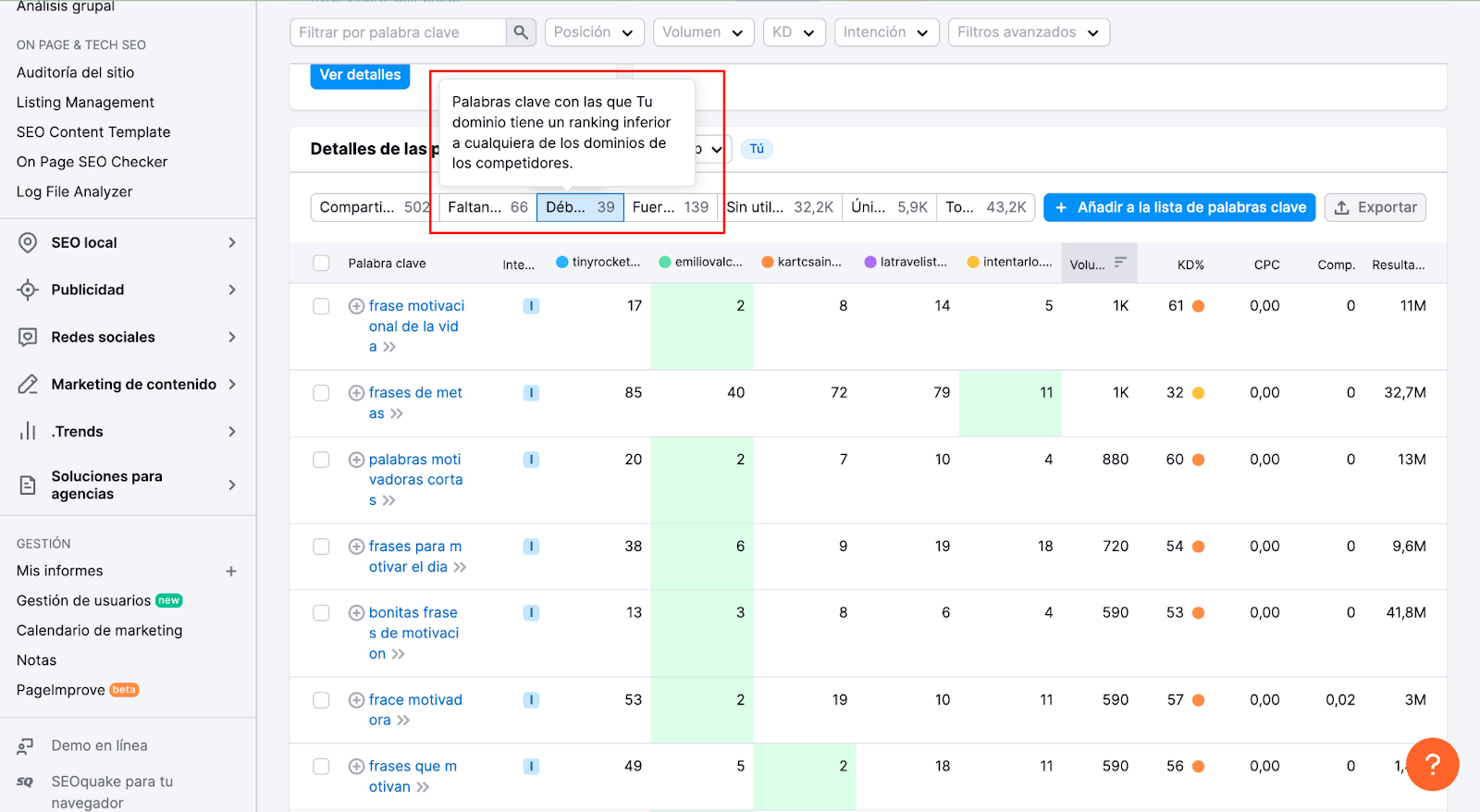
- You can also filter keywords by search intent, which will help you recognize and choose long-tail keywords more easily.
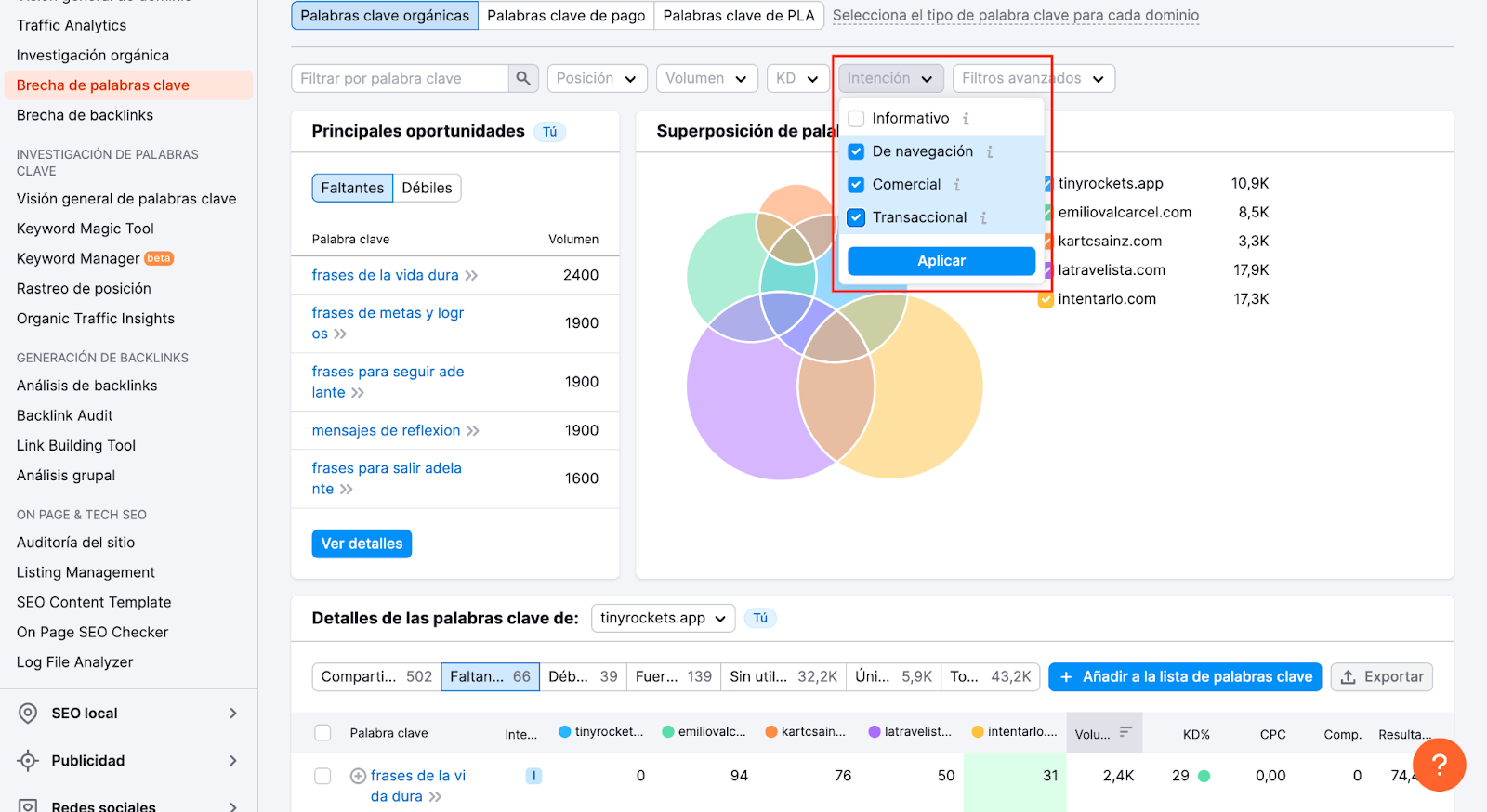
“Keywords Overview”
- Similar to Ahrefs’ Keyword Research, it differs in that it also provides the type of search intent.
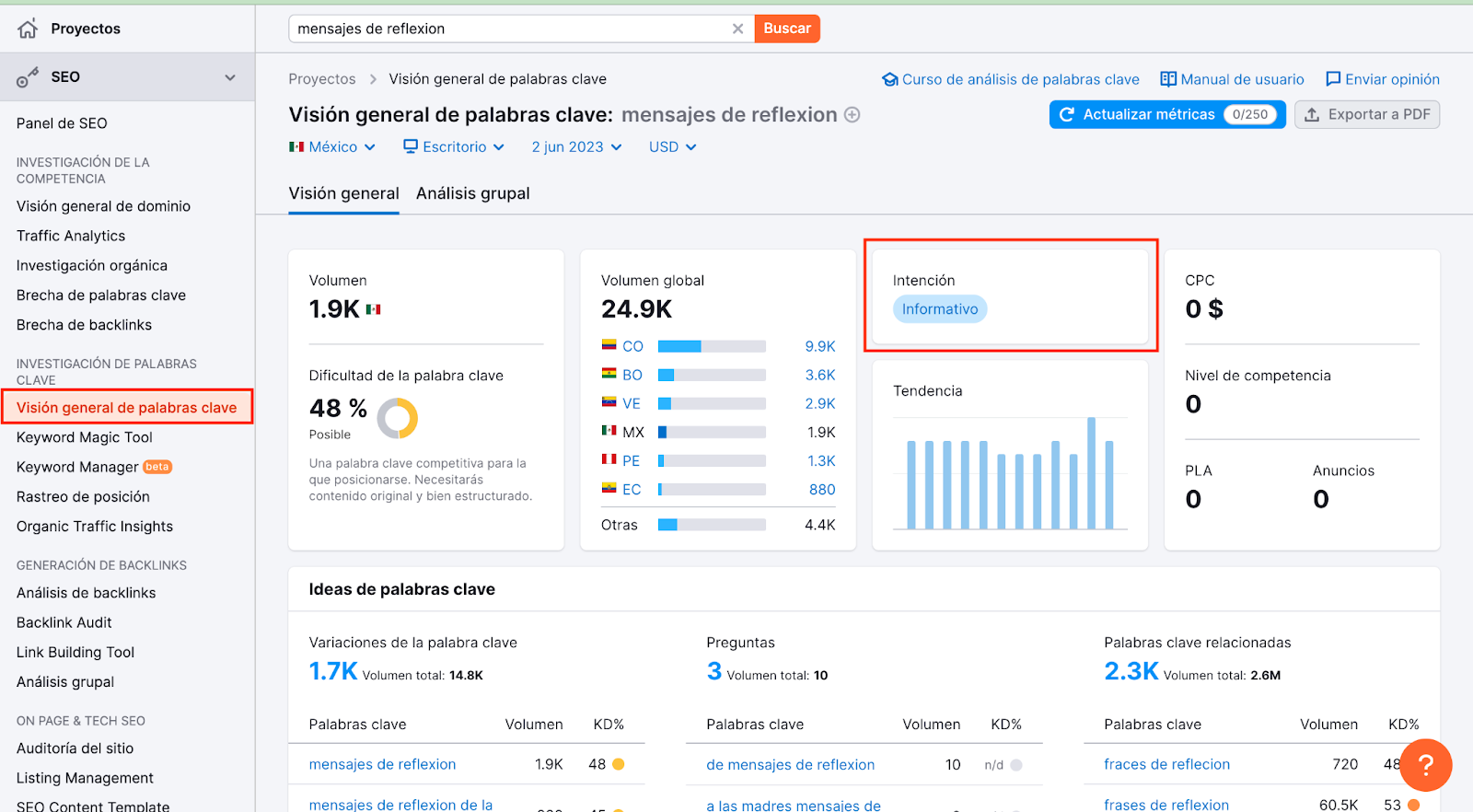
“Keyword manager”
- This new feature helps you build topic clusters around a seed keyword.
- It tells you the type of search intent to which the keyword is related, as well as the KD and search volume.
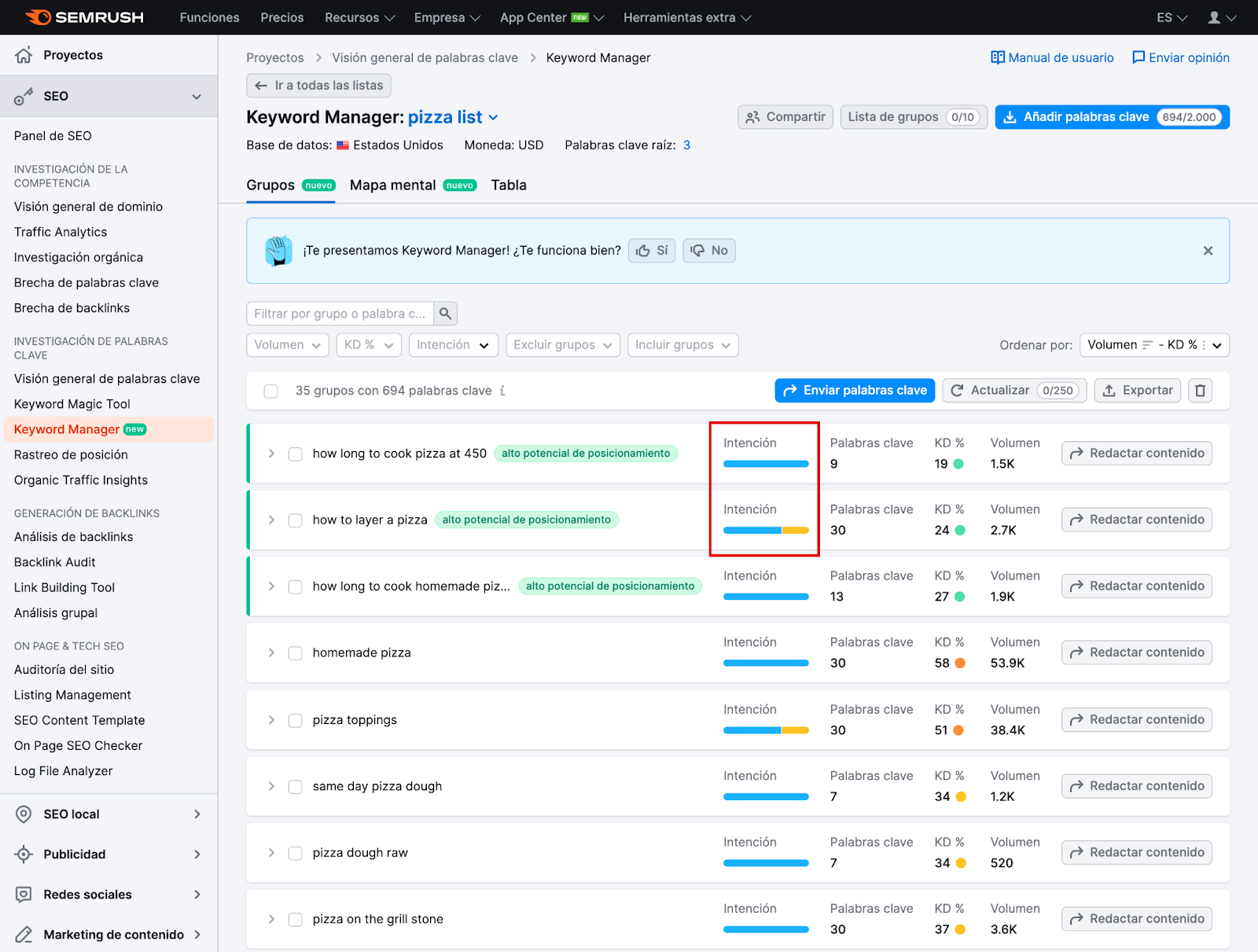
*For now it only works with the United States database, but it will soon be available for other databases as well.
Summary table:
Just like Ahrefs, the type of keywords you find with the different Semrush tools will depend on your search or URL initially analyzed.
3. Google
With the Google search engine you can find ideas for all kinds of keywords. Once you have the ideas, you will have to complement them with other SEO tools to project your chances of ranking with that keyword.
Autosuggest
This option gives you ideas for search variations based on a base keyword, usually short-tail.

⚠️ You should keep in mind that this Google feature is designed to show you popular searches. So this way of searching for keywords is mostly for finding short-tail keywords.
People Also Asked (PAA)
This search feature can give you, in addition to mid-tail or even long-tail topic ideas, ideas for headings 2 or 3 within a specific topic. As well as suggested questions for FAQ sections.
Question suggestions will depend on the search you performed and function primarily as a next search you might want to perform. Their nature will be mostly informational search intent.
⚠️ If your first search was with short-tail keywords, the questions returned are probably more towards short and mid-tail.
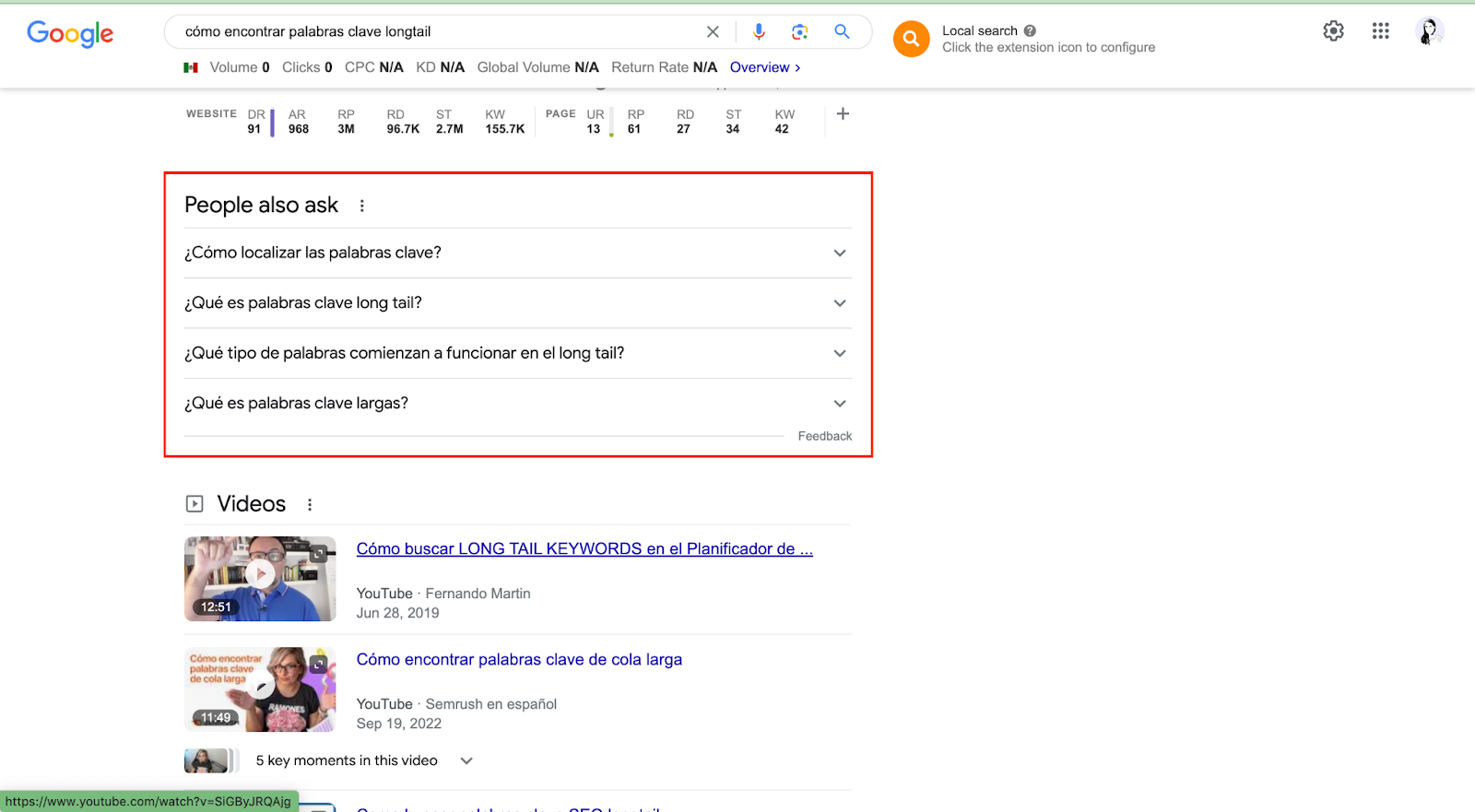
Competitors
You can simply Google short-tail or mid-tail keywords in your area and find out which websites are ranking for these searches. From this list of competitors, you can evaluate them in other tools, such as Ahrefs, to extract the keywords that bring the most organic traffic to your website.
- Search example:

- Example of players to evaluate:
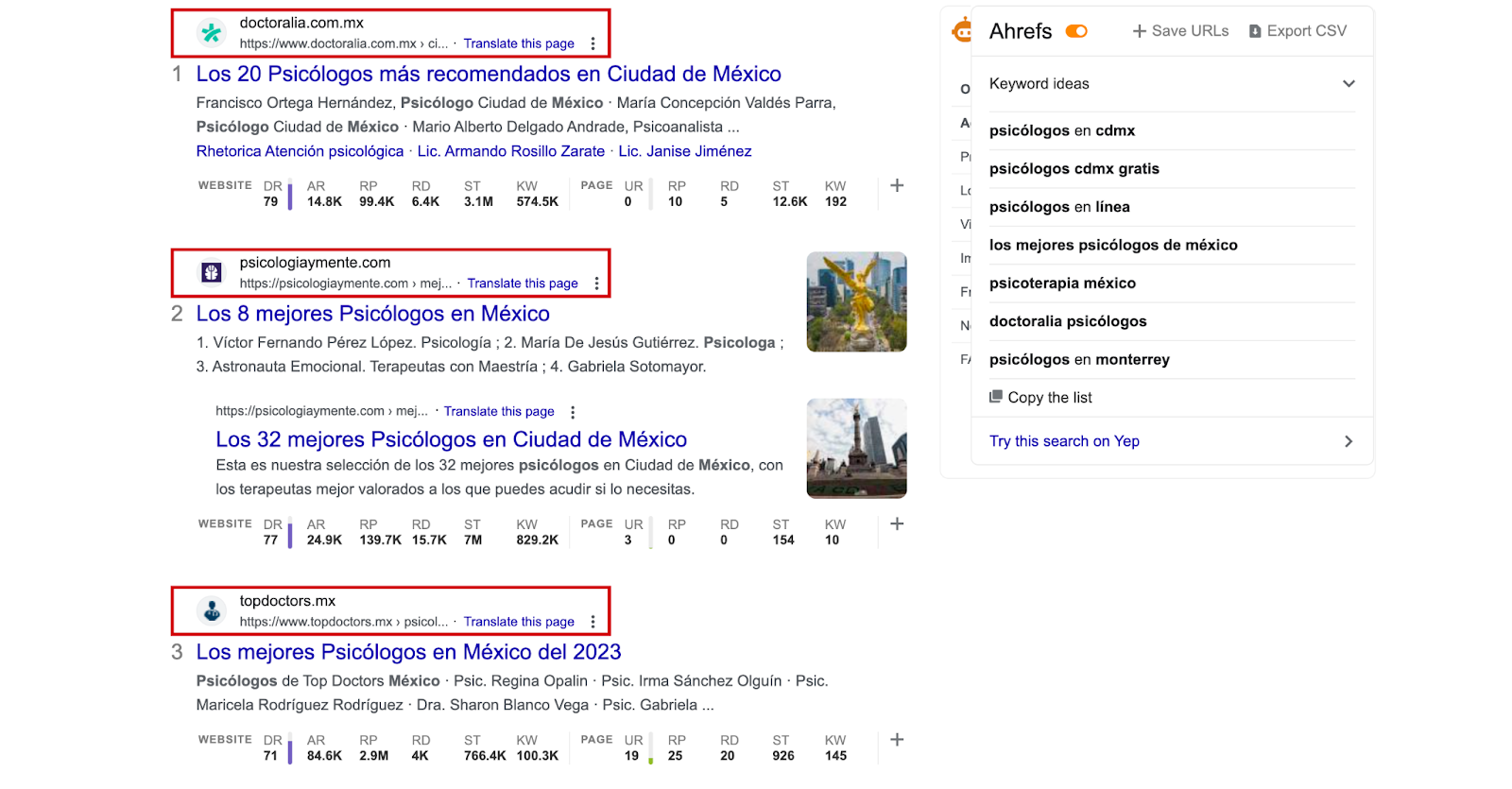
Googling 'site:www.sitioweb.com/ “keyword”'
This method is ideal for finding potential mid- and long-tail keywords from your competitors around a short-tail search. This method will show you all the landing pages that contain the term you are searching for.
- Example: site:www.tinyrockets.app/ "habits"
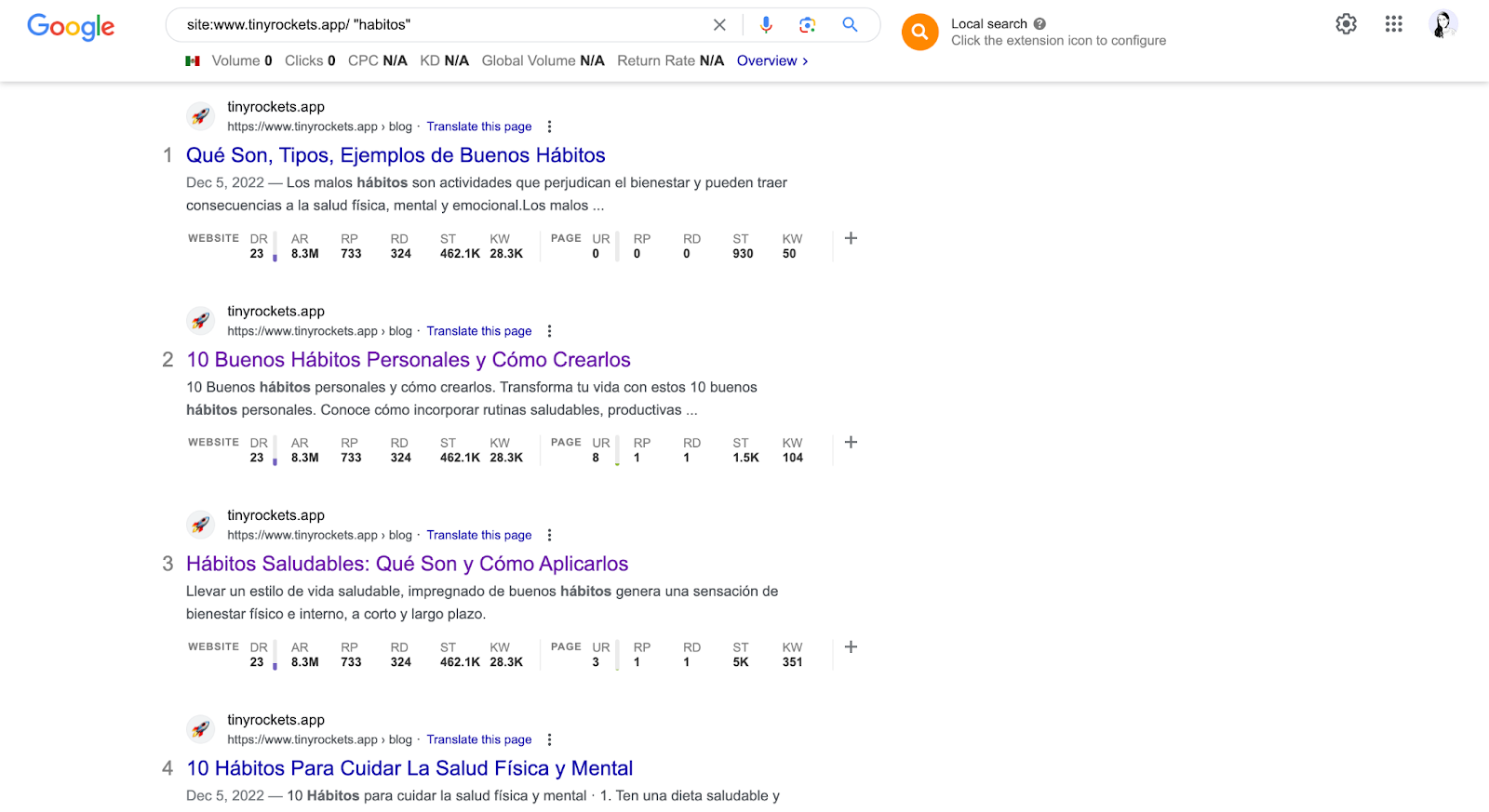
Summary table:
With these different ways of googling you can find the following types of keywords:
4. Answer the Public
This tool is based on the possible searches suggested by Google’s algorithm in the “similar searches” feature, so it will mainly show you popular searches. This means that this way of finding keywords is mainly for finding short and mid-tail keywords.
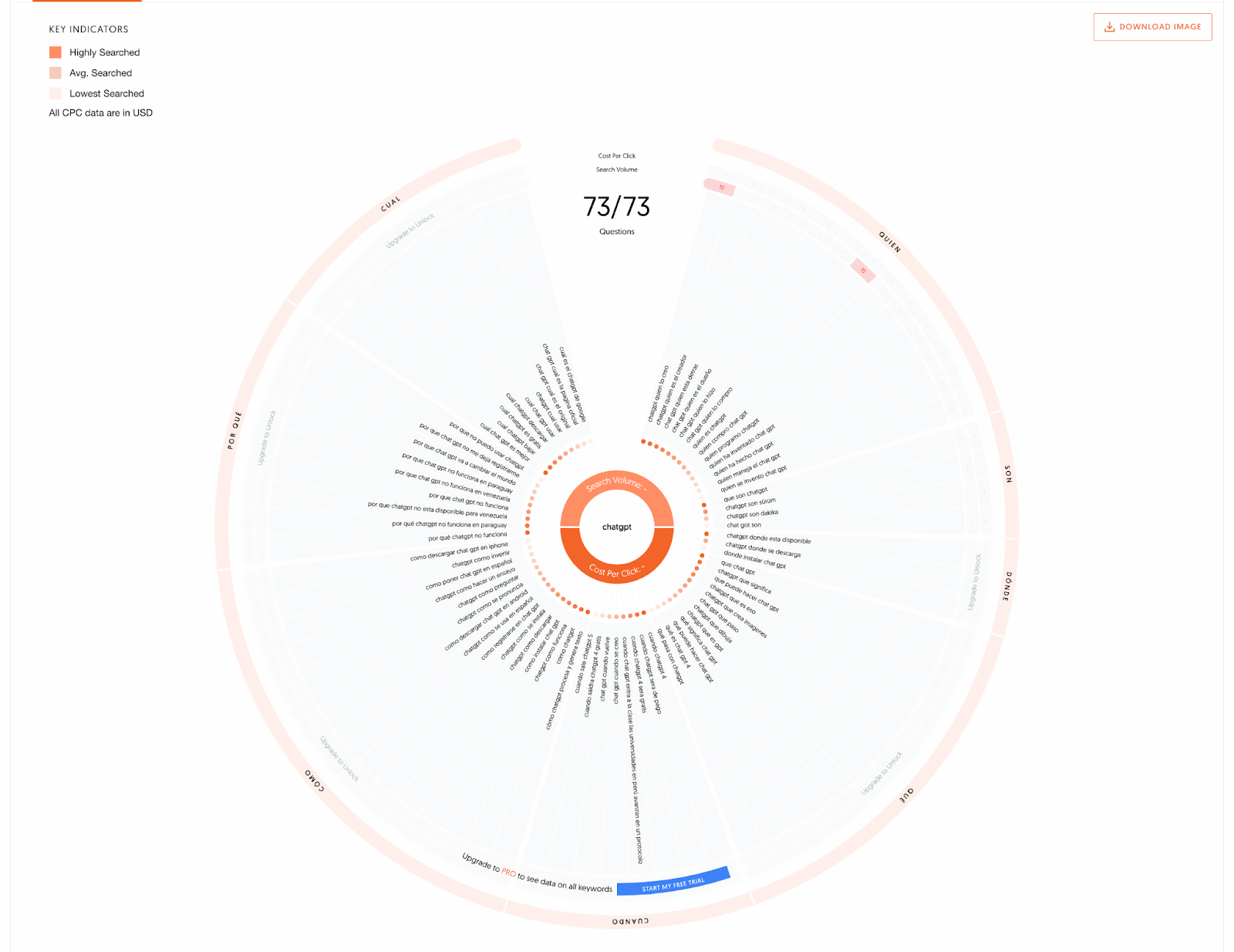
Summary table:
5. AlsoAsked
AlsoAsked collects and graphically projects information from Google’s “ People Also Asked ” feature, which we discussed earlier.
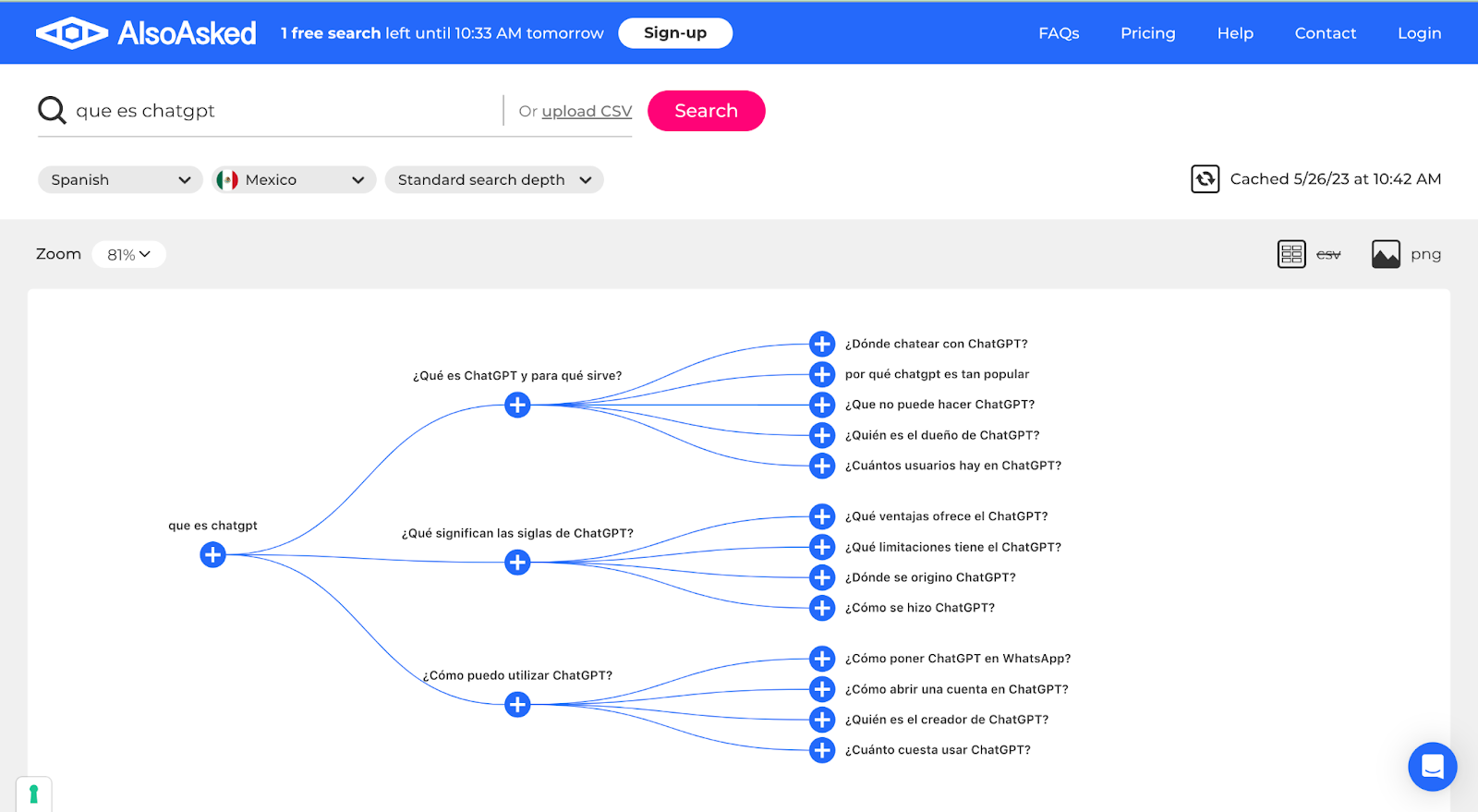
Summary table:
6. Quora, Reddit and other niche forums
The good thing about these methods is that these forums contain good discussions that can give you a lot of ideas, but it can be a tedious process as you can go down rabbit holes that are not profitable. Also, you will need to check the volume, potential traffic and KD of the keyword ideas with an SEO tool.
Questions on Quora
Quora is a good place to find not-so-popular questions that contain long-tail keywords.
Discussions on Reddit
Google any term from your industry + reddit and see what is being talked about or search directly within the Reddit platform . It helps to find especially popular topics, probably short-tail and mid-tail keywords but you might find good long-tail keywords if you dig deep into the questions-



Summary table:
Other tools you can explore to find keywords:
Checklist to find keywords
When searching for keywords, you can have this checklist on hand with the different ways to find keywords:
Ahrefs
- Keywords from competitors and your own website: “Site explorer - Top pages”
- Keywords from competitors and your own website: “Site explorer - Organic keywords”
- Competitors' keywords: “Site explorer - Organic competitors - Competitor's keywords”
- “Keywords explorer”
- Keywords from a search or landing page | Keywords from a landing page ( “KW” )
- Keywords from a search | “Related searches”
Semrush
- Competitor Keywords: “Keyword Gap”
- “Keywords Overview”
- Autosuggest
- PAA ( People Also Asked )
- Related searches or Similar searches
- Discover competitors
- Google 'site:www.sitioweb.com/ “keyword”'
Answer the Public
AlsoAsked
Niche Forums
- Quora
Where to use keywords on a landing page
- In the title tag: the title of the page influences the “ findability ” of the landing page.
- In the main title or heading 1.
- In headings 2, 3 or 4: the headings must be optimized, without repetitive with the keyword in all the titles of the content.
- In the meta description.
- In the URL.
- In the body of the content.
Some SEO tools, such as clearscope.io, can help you optimize content for keyword usage.
⚠️ Important: When optimizing with keywords, the best practice will always be to do it in a natural way that is really helpful for the user.
Overview of keyword types and SEO in 2024
Many people in the field are already talking about possible predictions in SEO with the integration of artificial intelligence (AI).
But why would artificial intelligence affect keyword types and SEO?
Google is already testing its new search experience called “ Search Generative Experience ” (SGE), in which the SERP we are used to changes, highlighting in position 0 the result generated by AI that responds to the user's search.
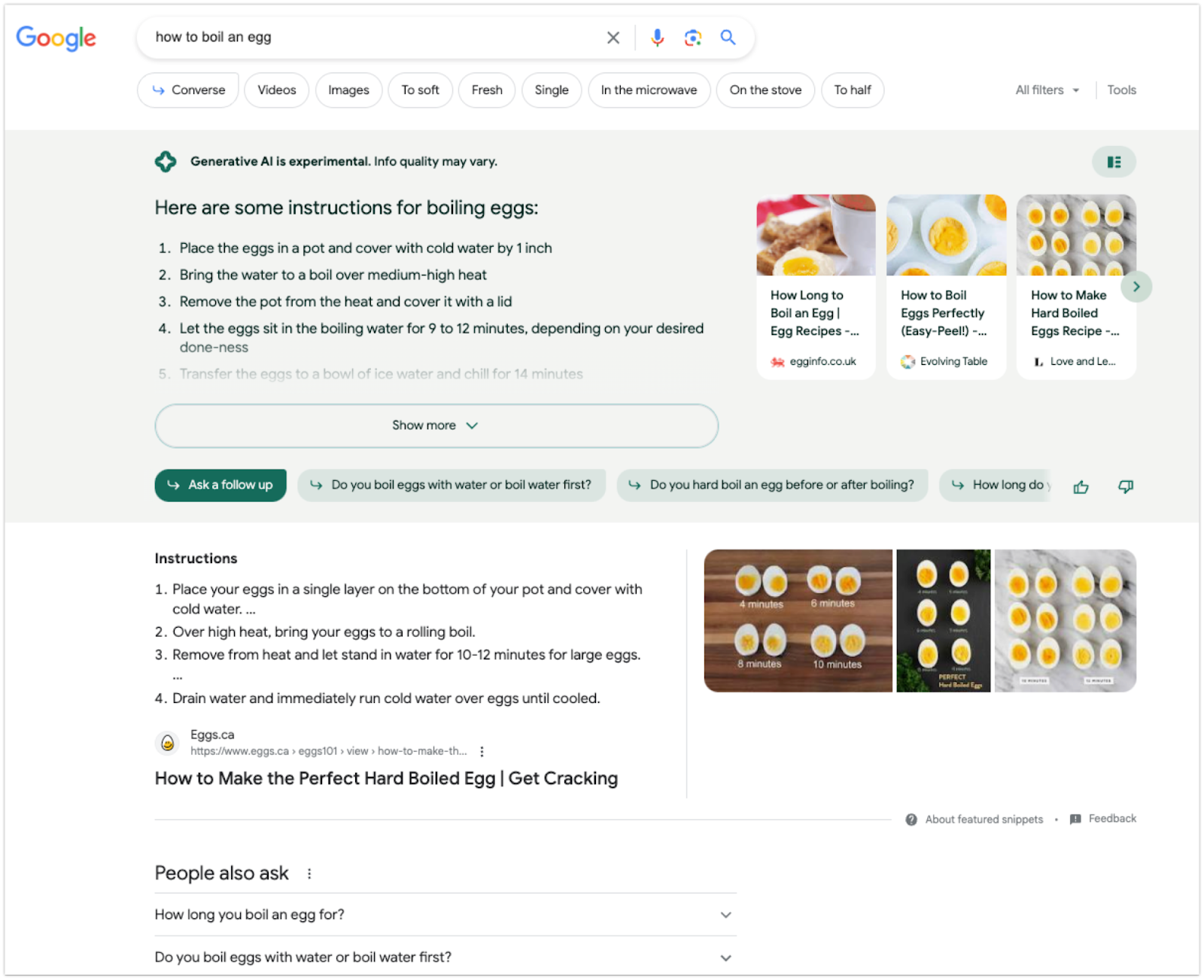
The new experience still leaves the rest of the results at the end of answer 0, but this first result takes up so much space on the SERP screen that users are unlikely to continue scrolling to read the rest of the results.
How can you appear in the zero result?
The criteria for which results are taken into account to generate the AI response is probably based on the authority of the website with respect to the search or keyword being discussed. However, Google has not published new guidelines to confirm this.
This is where building content hubs around keywords related to your products and services is probably more important . Also, unique and genuine content will have more weight, and this is usually reflected more in long-tail keywords.
Search intent and potential traffic
Once you manage to appear on the pages used for the AI-generated response, you will have a much better chance of getting the user's click, however, overall, potential traffic will drop considerably since many users might settle for the AI response.
Depending on the search intent, users will be interested in clicking on web pages, or they will be pleased with the AI's response.
For example, in an informational search, the user probably does not need to read more than the answer generated by Google. However, in commercial, transactional and navigational searches, there is a greater probability that the user is interested or needs to enter your page.
What to do once you have won the click?
If you get the user's click, your page must be further optimized for conversion, since the sales funnel probably decreases much more in its awareness stage, and focuses mainly on the consideration and purchase stages.
This is where optimizing your product and service pages at both the SEO and user experience levels comes into play, and as we well know, these pages usually target mid-tail or long-tail keywords.
In conclusion, we can predict that long-tail keywords will become increasingly important for your website to get traffic and conversions. And short-tail keywords will stop bringing in the most traffic, unless they are navigational searches.
